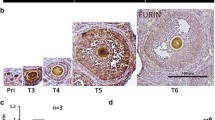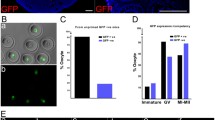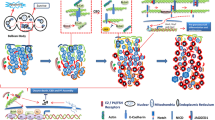Abstract
Purpose
To understand the mechanism of premature ovarian failure (POF).
Methods
The ultrastructural (electron microscopy) analysis of primordial ovarian follicles in Nobox deficient mice.
Results
We studied, for the first time, the fate of oogonia in embryonic (prenatal) mouse ovaries and showed that the abolishment of the transition from germ cell cysts to primordial follicles in the ovaries of Nobox deficient mice is caused by defects in germ cell cyst breakdown, leading to the formation of syncytial follicles instead of primordial follicles.
Conclusions
These results indicate that POF syndrome in Nobox deficient mice results from the faulty signaling between somatic and germ line components during embryonic development. In addition, the extremely unusual and abnormal presence of adherens junctions between unseparated oocytes within syncytial follicles indicates that faulty communication between somatic and germ cells is involved in, or leads to, abnormalities in the cell adhesion program.



Similar content being viewed by others
References
Choi Y, Rajkovic A. Genetics of early mammalian folliculogenesis. Cell Mol Life Sci. 2006a;63:579–90.
Choi Y, Rajkovic A. Characterization of NOBOX DNA binding specificity and its regulation of Gdf9 and Pou5f1 promoters. J Biol Chem. 2006b;281:35747–56.
Choi Y, Qin Y, Berger MF, Ballow DJ, Bulyk ML, Rajkovic A. A Microarray analyses of newborn mouse ovaries lacking Nobox. Biol Reprod. 2007;77:312–9.
Huntriss J, Hinkins M, Picton HM. cDNA cloning and expression of the human NOBOX gene in oocytes and ovarian follicles. Mol Hum Reprod. 2006;12:283–9.
Qin Y, Choi Y, Zhao H, Simpson JL, Chen ZJ, Rajkovic A. NOBOX homeobox mutation causes premature ovarian failure. Am J Hum Genet. 2007;81:576–81.
Qin Y, Shi Y, Zhao Y, Carson SA, Simpson JL, Chen ZJ. Mutation analysis of NOBOX homeodomain in Chinese women with premature ovarian failure. Fertil Steril. 2009;91:1507–9.
Rajkovic A, Pangas SA, Ballow D, Suzumori N, Matzuk MM. NOBOX deficiency disrupts early folliculogenesis and oocyte-specific gene expression. Science. 2004;305:1157–9.
Simpson JL. Genetic and phenotypic heterogeneity in ovarian failure: overview of selected candidate genes. Ann NY Acad Sci. 2008;1135:146–54.
Suzumori N, Yan C, Matzuk MM, Rajkovic A. Nobox is a homeobox-encoding gene preferentially expressed in primordial and growing oocytes. Mech Dev. 2002;111:137–41.
Suzumori N, Pangas SA, Rajkovic A. Candidate genes for premature ovarian failure. Curr Med Chem. 2007;14:353–7.
Kloc M, Bilinski S, Dougherty MT, Brey EM, Etkin LD. Formation, architecture and polarity of female germline cyst in Xenopus. Dev Biol. 2004;266:43–61.
Kloc M, Jaglarz M, Dougherty M, Stewart MD, Nel-Themaat L, Bilinski S. Mouse early oocytes are transiently polar: three-dimensional and ultrastructural analysis. Exp Cell Res. 2008;314:3245–54.
Pepling ME, Spradling AC. Female mouse germ cells form synchronously dividing cysts. Development. 1998;125:3323–8.
Bilinski SM, Jaglarz MK, Dougherty MT, Kloc M. Electron microscopy, immunostaining, cytoskeleton visualization, in situ hybridization, and three-dimensional reconstruction of Xenopus oocytes. Methods. 2010;51:11–9.
Choi Y, Yuan D, Rajkovic A. Germ cell-specific transcriptional regulator Sohlh2 is essential for early mouse folliculogenesis and oocyte-specific gene expression. Biol Reprod. 2008;79:1176–82.
Greenbaum MP, Yan W, Wu M-H, Lin Y-N, Agno JE, Sharma M, et al. TEX14 is essential for intercellular bridges and fertility in male mice. PNAS. 2006;103:4982–7.
Bogard N, Lan L, Xu J, Cohen RS. Rab11 maintains connections between germline stem cells and niche cells in the Drosophila ovary. Development. 2007;134:3413–8.
Cerda J, Reidenbach S, Pratzel S, Franke WW. Cadherin-catenin complexes during zebrafish oogenesis: heterotypic junctions between oocytes and follicle cells. Biol Reprod. 1999;61:692–704.
Hierholzer A, Kempler R. Beta-catenin-mediated signaling and cell adhesion in postgastrulation mouse embryos. Dev Dyn. 2010;239:191–9.
Duta S, Pepling ME (2009) A drop in maternal estradiol levels correlates with cyst breakdown and may affect meiotic cell cycle progression. Biol Rep. 81, abstract 479.
Chen Y, Jefferson WN, Newbold RR, Padilla-Banks E, Pepling ME. Estradiol, progesterone, and genistein inhibit oocyte nest breakdown and primordial follicle assembly in the neonatal mouse ovary in vitro and in vivo. Endocrinology. 2007;148:3580–90.
Monti M, Redi C. Oogenesis specific genes (Nobox, Oct4, Bmp15, Gdf9, Oogenesin1 and Oogenesin2) are differentially expressed during natural and gonadotropin-induced mouse follicular development. Mol Reprod Dev. 2009;76:994–1003.
Acknowledgements
We thank Elzbieta Kisiel for preparing the figures, Ada Jankowska for technical help and Prof. Elzbieta Pyza for providing electron microscopy facilities. This study was supported by the National Institutes of Health Grants HD44858, HD058125, and the 413 March of Dimes grant #6-FY08-313 to AR.
Author contribution
Agnieszka Lechowska processed EM samples and analyzed and interpreted data, Szczepan Bilinski analyzed and interpreted EM data, Youngsok Choi maintained mouse colonies and helped with interpretation of EM, Yonghyun Shin performed immunohistochemistry with Tex14 and interpreted the data, Malgorzata Kloc wrote the manuscript, analyzed data, coordinated study Aleksandar Rajkovic, conception, design and data analysis.
Author information
Authors and Affiliations
Corresponding authors
Additional information
Capsule Premature ovarian failure (POF) syndrome in Nobox deficient mice results from the faulty signaling between somatic and germ line components during embryonic development.
Rights and permissions
About this article
Cite this article
Lechowska, A., Bilinski, S., Choi, Y. et al. Premature ovarian failure in nobox-deficient mice is caused by defects in somatic cell invasion and germ cell cyst breakdown. J Assist Reprod Genet 28, 583–589 (2011). https://doi.org/10.1007/s10815-011-9553-5
Received:
Accepted:
Published:
Issue Date:
DOI: https://doi.org/10.1007/s10815-011-9553-5




